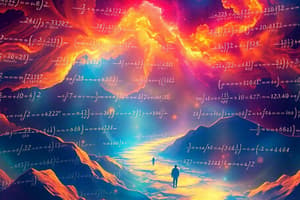Podcast
Questions and Answers
Which of the following best describes constants in algebra?
Which of the following best describes constants in algebra?
- They are fixed values that do not change. (correct)
- They are used exclusively in polynomial equations.
- They are always represented by letters.
- They change based on the variable's value.
What is the key operation performed when solving the equation y + 5 = 10?
What is the key operation performed when solving the equation y + 5 = 10?
- Substituting y with 5.
- Adding 5 to both sides.
- Multiplying both sides by 5.
- Isolating the variable y. (correct)
What form represents a linear equation?
What form represents a linear equation?
- x + y = z
- ax + b = 0 (correct)
- a(x - 2) = b
- ax² + bx + c = 0
Which method can be used for solving systems of equations?
Which method can be used for solving systems of equations?
What is the primary purpose of factoring in algebra?
What is the primary purpose of factoring in algebra?
Which of the following represents an inequality?
Which of the following represents an inequality?
What is represented by the notation f(x) in algebra?
What is represented by the notation f(x) in algebra?
How is a quadratic equation typically expressed?
How is a quadratic equation typically expressed?
Flashcards are hidden until you start studying
Study Notes
Algebra
Definition
- A branch of mathematics dealing with symbols and the rules for manipulating those symbols.
- Involves solving equations and understanding mathematical relationships.
Key Concepts
-
Variables
- Symbols (often letters) used to represent unknown values.
- Example: x, y, z.
-
Constants
- Fixed values that do not change.
- Example: 5, -3, π.
-
Expressions
- Combinations of variables, constants, and operations (addition, subtraction, etc.).
- Example: 3x + 4.
-
Equations
- Mathematical statements that assert the equality of two expressions.
- Example: 2x + 3 = 7.
-
Inequalities
- Expressions that show the relationship between two values that are not necessarily equal.
- Example: x + 3 > 5.
Operations
- Addition: Combining like terms (e.g., 2x + 3x = 5x).
- Subtraction: Removing terms (e.g., 5x - 2x = 3x).
- Multiplication: Distributing terms (e.g., 3(x + 2) = 3x + 6).
- Division: Splitting terms (e.g., 6x/3 = 2x).
Solving Equations
- Isolate the variable: Manipulate the equation to get the variable on one side.
- Inverse operations: Use opposite operations to solve (e.g., if y + 5 = 10, then y = 10 - 5).
- Check solutions: Substitute back into the original equation to verify.
Types of Equations
-
Linear Equations
- Form: ax + b = 0, where a and b are constants.
- Graph: Straight line.
-
Quadratic Equations
- Form: ax² + bx + c = 0, where a ≠ 0.
- Solutions found using factoring, completing the square, or the quadratic formula.
-
Polynomial Equations
- Involves terms with variables raised to whole number powers.
- Degree defines the highest exponent.
Functions
- A relationship between two sets, mapping each input to one output.
- Notation: f(x) represents the function in terms of x.
Factoring
- Breaking down expressions into products of simpler factors.
- Common methods: factoring out the greatest common factor (GCF), difference of squares, trinomials.
Systems of Equations
- Set of two or more equations with the same variables.
- Can be solved using substitution, elimination, or graphing methods.
Special Topics
- Exponents: Express repeated multiplication (e.g., x^n).
- Logarithms: The inverse of exponentiation, log_b(a) = c means b^c = a.
- Sequences and Series: Ordered lists of numbers and their summation.
Applications
- Used in various fields like engineering, physics, economics, and computer science.
- Essential for solving real-world problems involving rates, proportions, and optimization.
Definition
- Algebra focuses on symbols and the rules for manipulating them, facilitating the solving of equations and understanding mathematical relationships.
Key Concepts
- Variables: Symbols, commonly letters like x, y, z, representing unknown values.
- Constants: Fixed values that remain unchanged, such as numbers like 5, -3, and π.
- Expressions: Combinations of variables, constants, and operations (addition, subtraction), e.g., 3x + 4.
- Equations: Mathematical assertions of equality between two expressions, e.g., 2x + 3 = 7.
- Inequalities: Expressions indicating non-equal relationships between two values, e.g., x + 3 > 5.
Operations
- Addition: Combining like terms, e.g., 2x + 3x = 5x.
- Subtraction: Removing terms, e.g., 5x - 2x = 3x.
- Multiplication: Distributing terms, e.g., 3(x + 2) = 3x + 6.
- Division: Splitting terms, e.g., 6x/3 = 2x.
Solving Equations
- Isolate the variable: Rearranging the equation so the variable appears on one side.
- Inverse operations: Employing opposite operations to solve equations (e.g., if y + 5 = 10, then y = 10 - 5).
- Check solutions: Verifying solutions by substituting back into the original equation.
Types of Equations
- Linear Equations: Form is ax + b = 0, characterized by constants a and b; graphs as straight lines.
- Quadratic Equations: Form is ax² + bx + c = 0, with a ≠ 0; solutions obtained through factoring, completing the square, or quadratic formula.
- Polynomial Equations: Comprises terms with variables raised to whole number powers; degree is defined by the highest exponent.
Functions
- A relationship between two sets, where each input corresponds to a single output; represented by notation f(x) for the function in terms of x.
Factoring
- Decomposing expressions into products of simpler factors, utilizing methods such as factoring out the greatest common factor (GCF), difference of squares, and trinomials.
Systems of Equations
- Comprises two or more equations having the same variables; solvable via substitution, elimination, or graphical methods.
Special Topics
- Exponents: Denote repeated multiplication (e.g., x^n).
- Logarithms: Serve as the inverse of exponentiation; log_b(a) = c implies b^c = a.
- Sequences and Series: Ordered sequences of numbers and their cumulative summation.
Applications
- Algebra is crucial in fields like engineering, physics, economics, and computer science, addressing real-world problems involving rates, proportions, and optimization.
Studying That Suits You
Use AI to generate personalized quizzes and flashcards to suit your learning preferences.




